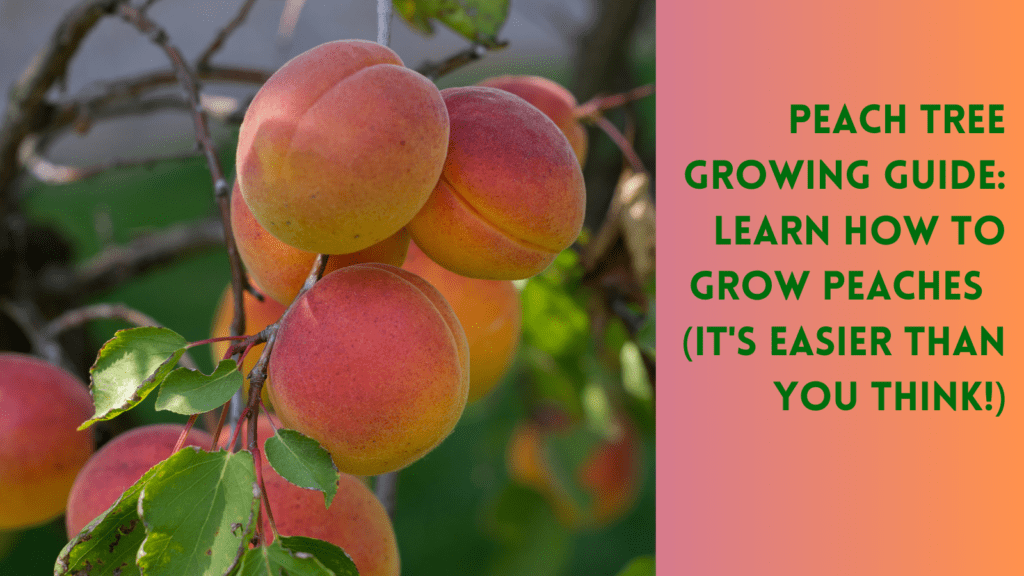Last Updated on: 18th September 2024, 12:27 pm
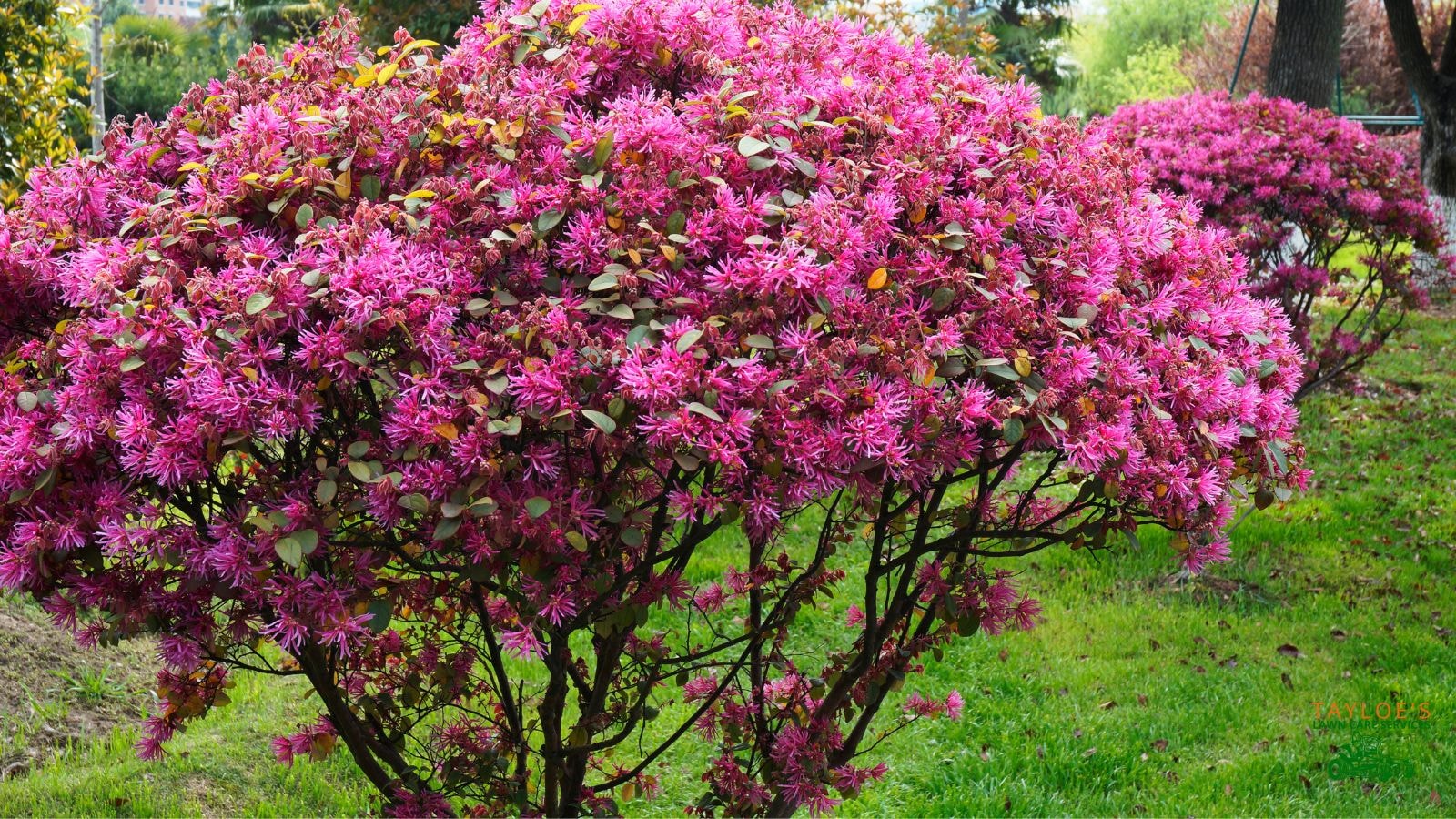
Loropetalum chinense, also known as the Chinese Fringe Flower, is an evergreen shrub or small tree with dazzling pink flowers and vibrant green foliage, bringing effortless elegance to any garden with minimal care.
About Loropetalum chinense
Loropetalum chinense captivates with its spidery blooms and richly textured foliage in shades of green, burgundy, or dark purple. Closely related to the witch hazel family, this shrub has been valued for centuries due to its beauty and ease of care.
Native to the woodlands of China, Japan, and the Himalayas, the Chinese Fringe Flower was introduced to Western horticulture in the 19th century, quickly becoming a favorite. Whether grown as a shrub or a small tree, its layered branches and ability to thrive in warmer climates make it ideal for both formal and informal gardens.
Blooming prolifically in early spring and sporadically throughout the growing season, loropetalum offers year-round interest, making it a go-to for gardeners seeking a low-maintenance shrub with attractive flowers.
Loropetalum Profile Summary
Common Name: Chinese Witch Hazel, Chinese Fringe Flower
Botanical Name: Loropetalum chinense
Plant Type: Evergreen shrubs
Family: Hamamelidaceae (Witch Hazel Family)
Mature Size: 1 to 10 feet tall, 3 to 10 feet wide (depending on variety, almost the height of ornamental trees)
Sun Exposure: Full sun to partial shade
Soil Type: Well-drained, rich in organic matter (Loam, chalk, or sandy)
Soil pH: Acidic (4.5 to 6.5)
Bloom Time: Early to mid-spring, with sporadic re-blooming
Flower Color and Characteristics: Pink flowers or white flowers, lightly fragrant, typically growing in clusters from the leaf axils.
Hardiness Zones: USDA zones 7-10
Toxicity: Non-toxic to dogs, cats, and children; however, ingestion of large amounts may cause mild stomach upset.
Deer Resistance: Relatively deer-resistant but may be grazed in areas with high deer populations.
Loropetalum chinense Varieties & Cultivars
A wide range of loropetalum cultivars is available, offering diverse flowering forms, growth habits, and sizes to suit various garden needs. Most of these varieties are ideal as specimen plants, making a bold statement in the landscape.
Here are some of the most popular:
‘Purple Pixie’: A dwarf cultivar with deep purple foliage, ideal for small spaces or cascading over containers. This variety performs best in full sun for optimal color and flowering.
‘Ruby’: A compact shrub featuring dark burgundy foliage in the spring that can mature into dark green leaves by late summer, along with striking hot pink flowers. Perfect for hedges or borders.
‘Burgundy’: Known for its dark burgundy foliage and dark pink flowers, adding bold color to any landscape.
‘Plum Delight’: One of the popular pink flowering varieties, offering dark purple foliage with clusters of dark pink fringe-like blooms. Its dense growth, with a mature size of 6-8 feet tall and wide, makes it suitable for mass plantings.
‘Purple Diamond’: Distinguished by its purple-leafed foliage and vibrant pink flowers with thin petals, creating a striking contrast in designs. The compact size of Purple Diamond makes it perfect for smaller garden spaces or as an accent plant.
‘Snow Muffin’: Semi-evergreen shrub with dark olive green foliage and delicate white flowers, providing a softer palette.
‘Sizzling Pink’: Features hot pink flowers with reddish-purple leaves, perfect for small gardens or container plantings.
‘Snow Dance’: A medium-sized shrub with elegant white flowers and lime green foliage, ideal for borders or foundation planting.
‘Fire Dance’: This striking variety is known for its vivid red flowers that stand out against its dark green foliage, making it an excellent choice for a bold garden statement.
How to Grow and Care for Loropetalum chinense
Growing and caring for loropetalum is simple, requiring just a few basic steps to ensure it thrives in your garden year-round.
Ideal Planting Time
For the best results, plant your Chinese fringe flower in the spring or fall when the temperatures are milder. Avoid planting during extreme heat or cold, as this can stress the plant and hinder its establishment.
Where to Plant Loropetalum
Choose a location that receives full sun to partial shade. While it can tolerate some shade, loropetalum will flower more profusely and retain its color better in areas with more sunlight.
Varieties like Purple Pixie and Plum Delight bloom best with ample sunlight, though Snow Muffin may tolerate slightly more afternoon shade.
Planting Loropetalum
Begin by amending the soil with compost or other rich organic matter to improve drainage and provide nutrients. Ensure the soil is loose and well-draining to prevent root issues.
Dig a hole that’s 2-3 times the diameter of the root ball and slightly shallower–to ensure adequate room for the roots to spread while preventing water from pooling at the base.
If the plant is root-bound, gently tease out any circling roots or carefully cut slashes in the root ball to promote new root growth. This is especially important for container-grown plants.
Place the plant in the hole so that the top of the root ball is level with or slightly above the surrounding soil.
Backfill the hole with soil, tamping it down gently to remove air pockets. Water thoroughly to help the soil settle around the roots and continue to water 1-2 times per week until the plant is established.
The spacing for loropetalum depends on the variety. Dwarf cultivars such as Purple Pixie may only need a few feet of space, while taller varieties may require 6-8 feet to accommodate their mature height of up to 10 feet tall and wide.
Loropetalum Chinense Care
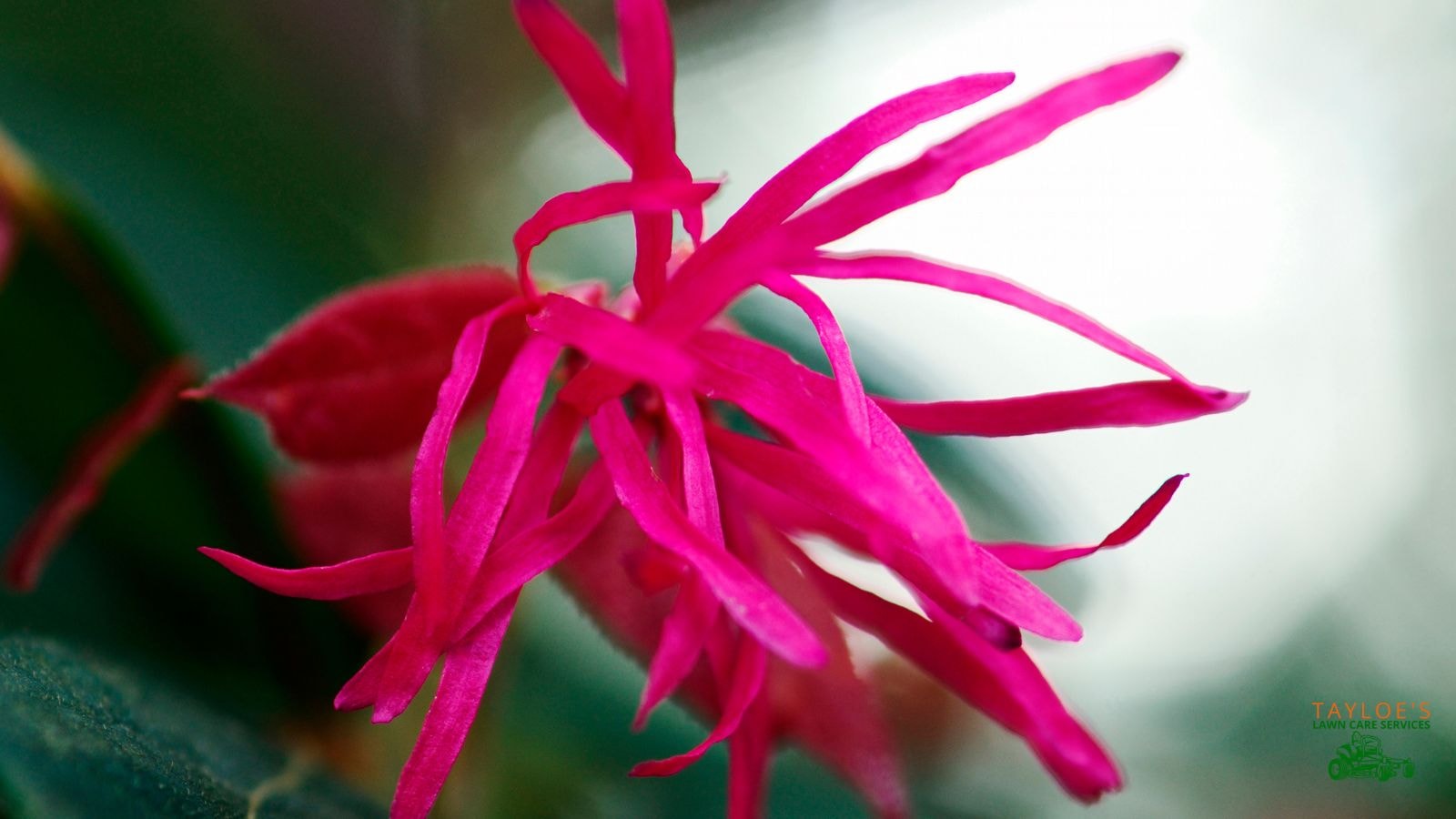
Watering
During the initial establishment phase, water your loropetalum once or twice a week to encourage strong root development. Once established, it becomes relatively drought tolerant and requires less frequent watering.
Ensure the top inch of soil dries out between waterings to avoid waterlogging, which could lead to root rot. In full sun, especially during hot, dry spells, you may need to water more frequently to keep the plant healthy.
Mulching
Apply mulch around the base of the plant to help retain moisture and regulate soil temperature. Mulching also helps suppress weeds and reduces the need for frequent watering during dry periods.
Fertilizing
Apply a slow-release fertilizer in early spring to give the plant a nutrient boost as it prepares for its blooming season. This is especially important for cultivars like Plum Delight and Purple Pixie, which need sufficient nutrients to produce their dazzling flowers and colorful foliage.
Avoid over-fertilizing, as this can lead to excessive leaf growth at the expense of flowers.
Pruning
Prune your loropetalum after the main blooming period in spring. Regular pruning will maintain the plant’s shape and encourage more robust new growth.
Remove dead or diseased branches and thin out overcrowded sections to improve air circulation and prevent diseases.
Overwintering Loropetalum chinense
While the tough Chinese fringe flower, loropetalum, is hardy in USDA zones 7-10, extra protection is needed in colder climates to shield it from freezing temperatures. Apply a 3-4 inch layer of mulch around the base to insulate the roots.
For younger plants or areas with severe frost, cover the shrub with burlap or frost blankets to shield against freezing winds and frost damage. Position the plant in a sheltered area to protect it from icy winds.
Pest and Disease Control
Although loropetalum is generally pest-resistant, aphids or spider mites can occasionally become an issue. To manage aphids, use insecticidal soap or neem oil, and remove affected leaves to prevent further spread.
For spider mites, consider hosing them off with a high-pressure stream of water to remove the pests.
Poor air circulation can also lead to diseases like powdery mildew or branch dieback. Prune crowded areas to improve airflow, especially in mass plantings, and avoid overwatering, as excess moisture can trigger fungal infections.
Common Loropetalum Issues:
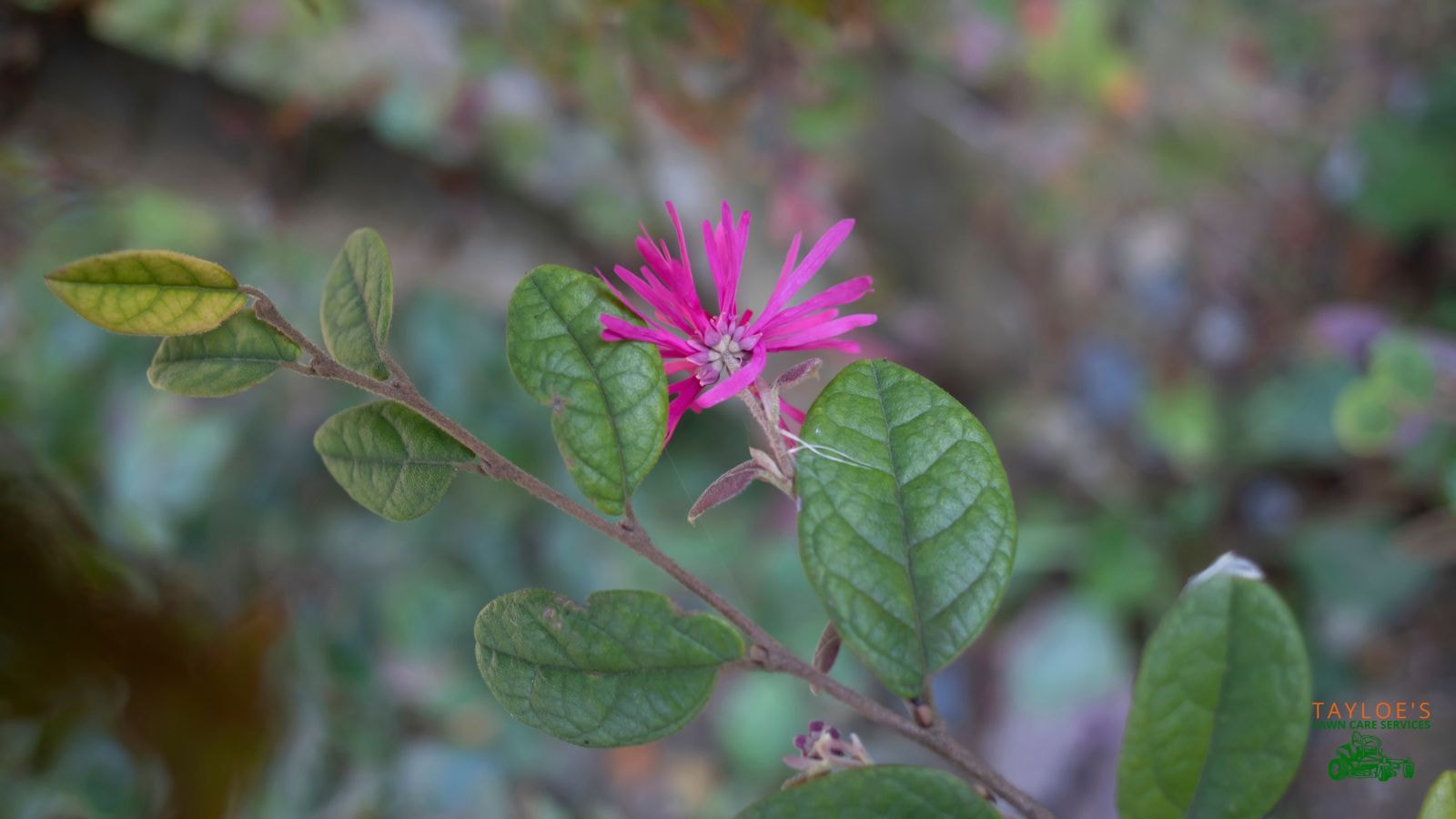
Loropetalum is relatively hardy, but a few issues may arise if conditions are not ideal:
Drainage Problems
Chinese fringe flower struggles in poorly drained soils.
Ensure your soil is well-draining to avoid root rot, bacterial gall disease, and branch dieback. These are common in overly saturated soils, especially in areas prone to heavy rainfall.
Chlorosis in Alkaline Soils
If leaves turn yellow, it often signals chlorosis caused by alkaline soil. Amend the soil with organic matter or sulfur to restore its acidic pH (4.5–6.5).
Fungal Issues
High humidity can lead to leaf spot or powdery mildew. Improve air circulation through proper pruning and avoid overhead watering.
Frost Damage
In colder climates, protect younger loropetalum from frost by mulching and covering during freezing temperatures.
Propagating Loropetalum chinense
Loropetalum chinense propagation is mainly through cuttings, layering, or division.
Cuttings
Take 4-6 inch stem cuttings from healthy plants during the summer. Select vigorous stems with new growth and vibrant foliage, including deep purple leaves (depending on the variety), to ensure successful propagation.
Strip the lower leaves and dip the cuttings in rooting hormone. Plant them in a well-draining potting mix and place in a location with partial shade to promote rooting.
Layering
Select a low-hanging branch and gently bend it toward the ground. Bury a section of the stem while leaving the tip exposed.
Over time, the stem will root in the well-draining soil. Once rooted, it can be cut from the parent plant and transplanted.
Division
For mature, multi-stemmed plants, divide the root ball carefully in early spring or fall. This method works best with dwarf cultivars like Purple Pixie and Snow Muffin, ensuring the divisions have strong roots.
Growth Rate and Mature Height/Spread
The growth rate of Loropetalum chinense depends on the variety. Upright, taller cultivars grow at a medium to fast rate, often reaching up to 10 feet tall and spreading 3-10 feet wide. They are perfect for creating height and structure in gardens.
For smaller spaces, a dwarf cultivar like Purple Pixie is ideal, growing only 1-3 feet tall and wide, making it suitable for borders, container plantings, or foundation plantings. Its compact size allows it to fit into tight spaces without sacrificing beauty or impact.
Garden Design and Landscaping with Loropetalum chinense
Loropetalum offers incredible versatility in the landscape, fitting into various garden styles and settings. Here are nine ways to make the most of this beautiful shrub:
Hedges and Screens: Taller varieties, such as ‘Ruby’, and ‘Plum Delight’ work well as natural privacy screens or hedges. Their dense foliage provides year-round coverage while adding vibrant color to borders.
For a semi-dwarf variety, try out the ‘Purple Diamond’ cultivar.
Foundation Plantings: Place loropetalum near buildings or patios as a foundation plant to soften architectural lines. Its layered branching and vibrant foliage add elegance while minimizing the harshness of hardscapes.
Mixed Borders: For a dynamic look, pair loropetalum with flowering shrubs and perennials. Its contrasting colors, like deep purple foliage, white flowers, and hot pink blooms, add visual interest to mixed beds.
Groundcovers: Dwarf varieties like ‘Purple Pixie’ spread nicely, making them ideal for covering bare patches in the garden or under taller shrubs. Their compact form also helps suppress weeds.
Container Planting: Use smaller cultivars in decorative pots to brighten patios or entryways. Loropetalum’s evergreen foliage makes it an excellent choice as a container plant, keeping containers looking full year-round, with pops of seasonal color from its flowers.
Accent Plants: Place loropetalum as a specimen plant to create a striking focal point in garden beds or near pathways. Its vibrant foliage and arching branches add grace and elegance to any design.
Erosion Control: On sloped or uneven terrain, loropetalum helps stabilize soil with its dense root system. Plant it on hillsides to prevent soil erosion while adding beauty to difficult landscapes.
Rock Gardens: Incorporate loropetalum into rock gardens for contrast against stone textures. Its colorful foliage and delicate flowers soften the hard lines of rocks, while its ability to thrive in well-drained soil makes it a perfect fit.
Wildlife Gardens: The lightly fragrant blooms of loropetalum attract pollinators like bees and butterflies. Plant it in wildlife-friendly gardens to encourage biodiversity while adding beauty to the space.
Companion Plants
Loropetalum pairs beautifully with:
Camellias: These evergreen shrubs offer structure and bloom in whites, pinks, or reds, balancing loropetalum’s vivid foliage and pink flowers.
Azaleas: Their delicate blooms complement the pink flowers of loropetalum, and both thrive in partial shade and well-draining soil.
Ornamental Grasses: Soft grasses like Carex or Miscanthus add texture and movement, contrasting the dense growth habit of loropetalum.
Perennials: Plants like Hostas, Heucheras, and Ferns add texture and color contrast to loropetalum’s dark purple and burgundy foliage.
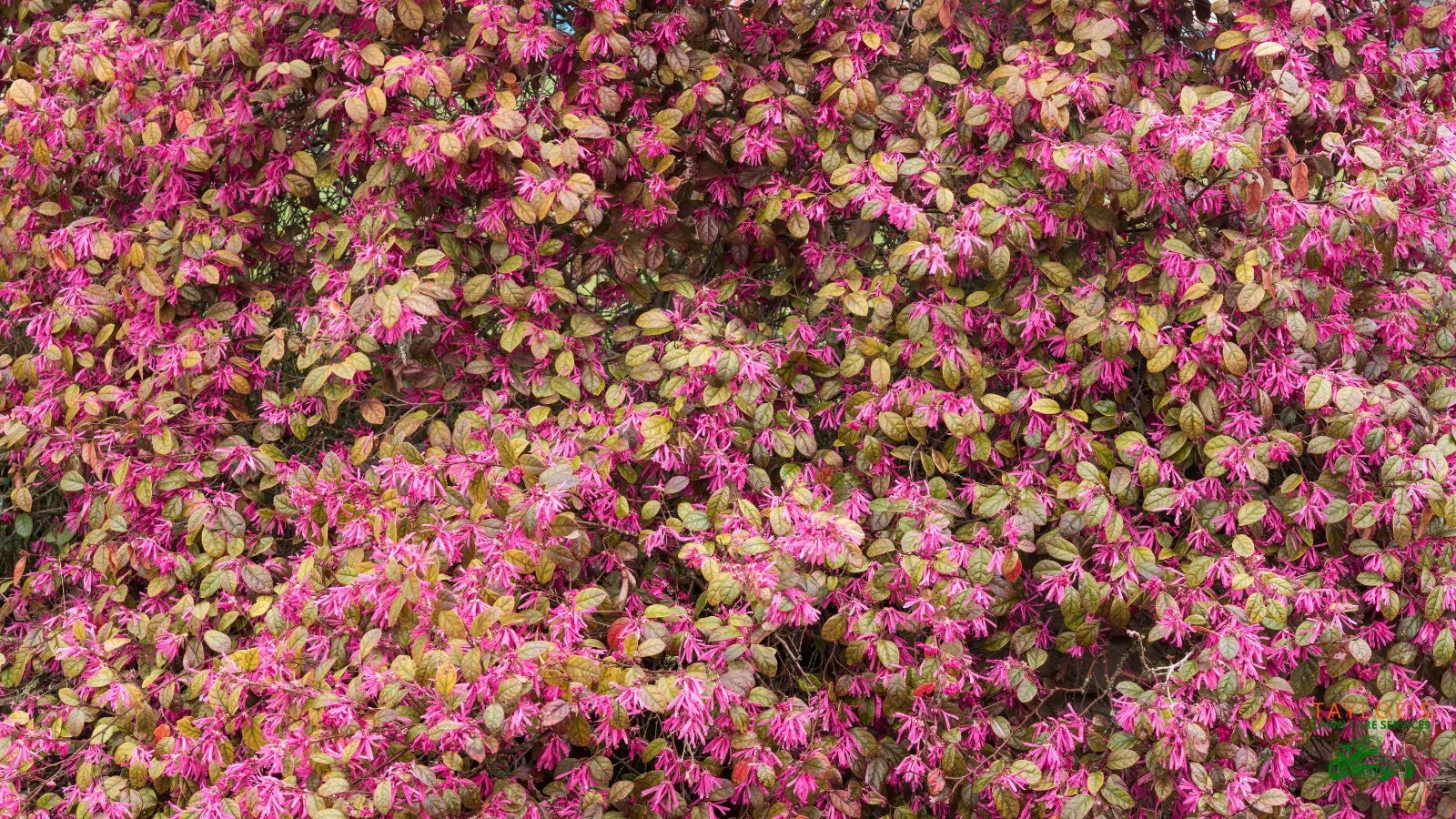
You’ll Love the Foliage Color of Loropetalum (Chinese Fringe Flowers)
Loropetalum is the perfect choice for adding vibrant, year-round interest to your garden. Its stunning foliage, paired with pink flowering forms or delicate white flowering forms, makes it ideal for foundation plantings, hedges, or as a stand-alone focal point.
By following the tips outlined in this guide, you can easily grow and maintain this low-maintenance shrub.
Ready to enhance your landscape with drought-tolerant, lovely white or dark pink flowers? Start planting Loropetalum chinense today and watch your garden transform!
For more expert tips, connect with Tayloe’s Lawn Care Services, LLC on Facebook.
Author Profile

- Maureen Abuor
- Maureen Abuor is a professional content marketing strategist and SEO strategist, with particular knowlege of creating landscaping and gardening content that informs and delights her audience. When she's not working, she's a busy mother of three precious little ones and child of God.
Latest entries
 Lawn CareApril 29, 2025Best shady area grass seed for Eastern NC
Lawn CareApril 29, 2025Best shady area grass seed for Eastern NC GardeningApril 15, 2025How do I make organic soil for the garden?
GardeningApril 15, 2025How do I make organic soil for the garden? Flower GardenMarch 7, 2025What are wave petunias?
Flower GardenMarch 7, 2025What are wave petunias? Flower GardenMarch 3, 202520 Full-sun annuals for your spring and summer garden
Flower GardenMarch 3, 202520 Full-sun annuals for your spring and summer garden






